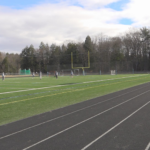
SOUTH BURLINGTON, Vt. (WCAX) – Right now, South Burlington High School senior Finn McCarney’s days are spent on the turf with his lacrosse team. But two years ago during his mountain biking season, McCarney was stuck in a dark room with a concussion.
“I missed three races, I missed the championship, and it was weird just not having that time to spend with my friends mountain biking,” McCarney recalled.
Concussions are the grand slam of sports-related injuries, impacting over one million athletes under 18 in the U.S. every year, according to research out of the University of Washington. SBHS Athletic Trainer Sierra Villemaire knows firsthand the struggle that comes with a concussion.
“What I see most is a lot of frustration,” Villemaire explained.
Current concussion protocol dating back to 2014 can keep concussed athletes away from play and school for long periods, which can lead to major mental health struggles.
“‘Oh no, I have a concussion, I have to wait so long to go back to play,’” Villemaire said her athletes say. “It can take a toll on their mental health for sure.”
New concussion guidelines from the Journal of Athletic Training, published Tuesday, could change that. They give athletic trainers and schools more leeway to get concussed athletes back to exercise and school faster, as long as symptoms are stable and not made worse. Athletes still need to hit certain recovery milestones to fully return to their team and classes, but they wouldn’t necessarily be closed off from the world.
“They don’t feel super secluded from the team, their friends, their peers,” Villemaire said.
State sport leaders say it’s a slam dunk for athletes and the trainers guiding their recovery.
“I think the language related to the unchallengeable authority of athletic trainers to make these decisions is a really big step in the right direction,” Mt. Abraham Union High School Athletic Director Devin Wendel said.
McCarney says he’s relieved that another concussion wouldn’t be a one-way ticket to isolation.
“It would allow me to return to school and lacrosse faster and that’s the goal, to just be able to slowly get back into it,” McCarney said. “That’s the best way to do it I think.”
The Vermont Principals’ Association says they’re reviewing the new guidelines and working to educate athletic directors and trainers across the state.
